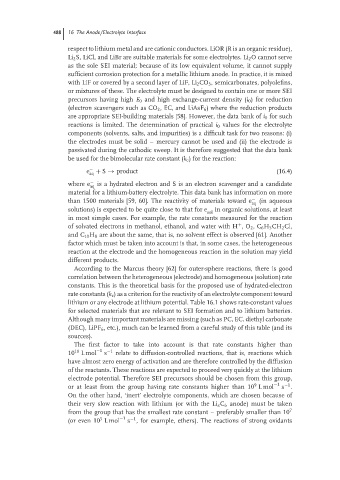Page 515 - Handbook of Battery Materials
P. 515
488 16 The Anode/Electrolyte Interface
respect to lithium metal and are cationic conductors. LiOR (R is an organic residue),
Li 2 S, LiCl, and LiBr are suitable materials for some electrolytes. Li 2 O cannot serve
as the sole SEI material; because of its low equivalent volume, it cannot supply
sufficient corrosion protection for a metallic lithium anode. In practice, it is mixed
with LiF or covered by a second layer of LiF, Li 2 CO 3 , semicarbonates, polyolefins,
or mixtures of these. The electrolyte must be designed to contain one or more SEI
precursors having high E 0 and high exchange-current density (i 0 ) for reduction
(electron scavengers such as CO 2 ,EC, andLiAsF 6 ) where the reduction products
are appropriate SEI-building materials [58]. However, the data bank of i 0 for such
reactions is limited. The determination of practical i 0 values for the electrolyte
components (solvents, salts, and impurities) is a difficult task for two reasons: (i)
the electrodes must be solid – mercury cannot be used and (ii) the electrode is
passivated during the cathodic sweep. It is therefore suggested that the data bank
be used for the bimolecular rate constant (k e ) for the reaction:
e + S → product (16.4)
−
aq
where e − is a hydrated electron and S is an electron scavenger and a candidate
aq
material for a lithium-battery electrolyte. This data bank has information on more
than 1500 materials [59, 60]. The reactivity of materials toward e − (in aqueous
aq
solutions) is expected to be quite close to that for e − in organic solutions, at least
sol
in most simple cases. For example, the rate constants measured for the reaction
+
of solvated electrons in methanol, ethanol, and water with H ,O 2 ,C 6 H 5 CH 2 Cl,
and C 10 H 8 are about the same, that is, no solvent effect is observed [61]. Another
factor which must be taken into account is that, in some cases, the heterogeneous
reaction at the electrode and the homogeneous reaction in the solution may yield
different products.
According to the Marcus theory [62] for outer-sphere reactions, there is good
correlation between the heterogeneous (electrode) and homogeneous (solution) rate
constants. This is the theoretical basis for the proposed use of hydrated-electron
rate constants (k e ) as a criterion for the reactivity of an electrolyte component toward
lithium or any electrode at lithium potential. Table 16.1 shows rate-constant values
for selected materials that are relevant to SEI formation and to lithium batteries.
Although many important materials are missing (such as PC, EC, diethyl carbonate
(DEC), LiPF 6 , etc.), much can be learned from a careful study of this table (and its
sources).
The first factor to take into account is that rate constants higher than
10 10 L mol −1 s −1 relate to diffusion-controlled reactions, that is, reactions which
have almost zero energy of activation and are therefore controlled by the diffusion
of the reactants. These reactions are expected to proceed very quickly at the lithium
electrode potential. Therefore SEI precursors should be chosen from this group,
9
−1
or at least from the group having rate constants higher than 10 L mol −1 s .
On the other hand, ‘inert’ electrolyte components, which are chosen because of
their very slow reaction with lithium (or with the Li x C 6 anode) must be taken
from the group that has the smallest rate constant – preferably smaller than 10 7
5
−1
(or even 10 L mol −1 s , for example, ethers). The reactions of strong oxidants

